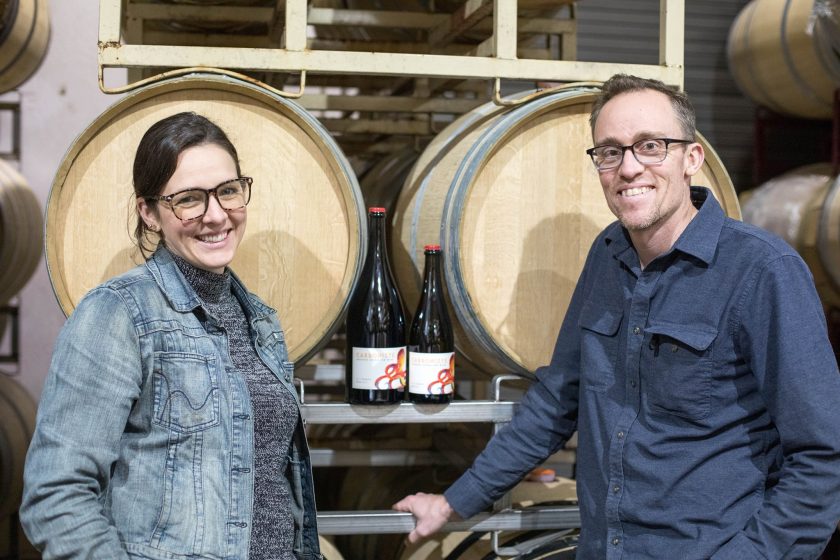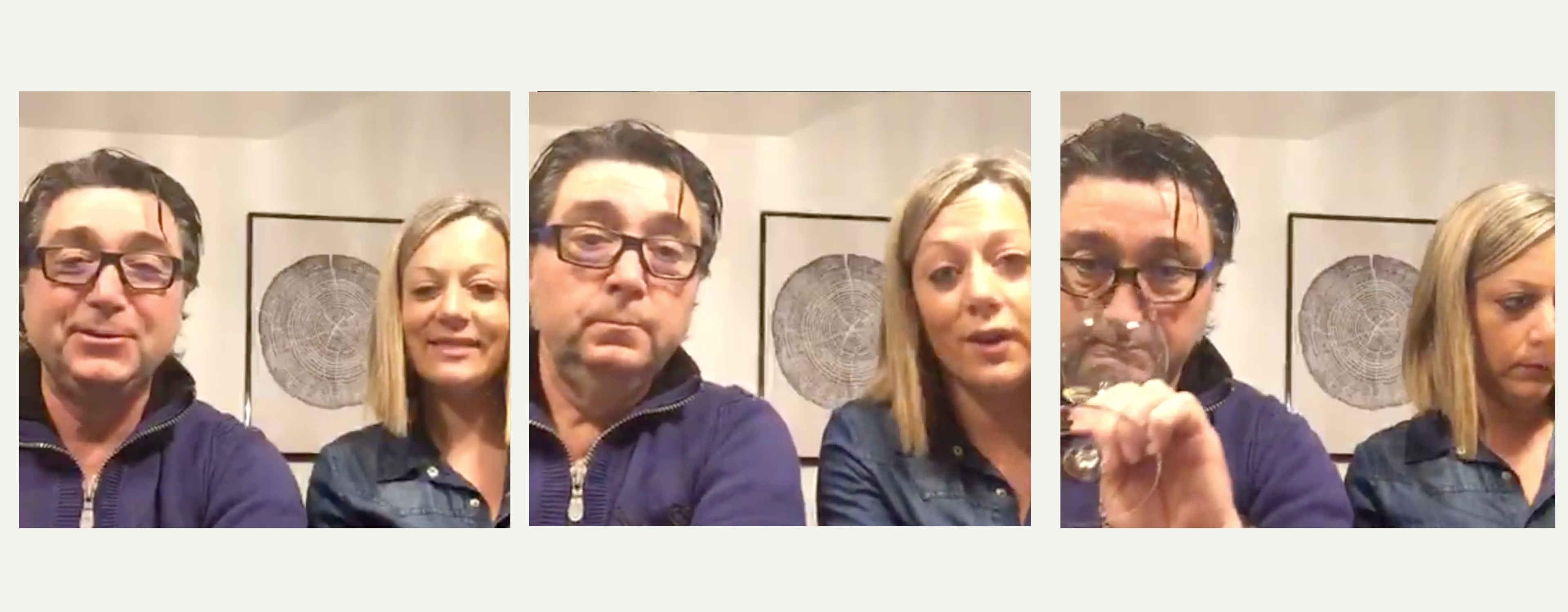Above: Jacqueline & Dan Person of CARBONISTE.
Reimagine California sparkling wines with the lineup of individual,
regional expressions from CARBONISTE.
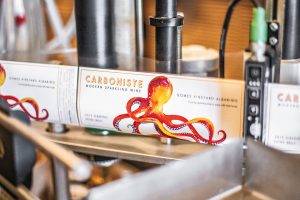 Husband and wife duo Dan and Jacqueline Person are producing some of the most innovative expressions of California sparkling wines out there. This smaller, younger (read: get in early with this brand!) Napa-based operation hit their stride with three flagship items, a bubbly Albariño, a fizzy rosé, and a pét-nat Pinot Grigio, while also perfecting some single-vineyard projects that represent unique, cool-climate California terroirs.
Husband and wife duo Dan and Jacqueline Person are producing some of the most innovative expressions of California sparkling wines out there. This smaller, younger (read: get in early with this brand!) Napa-based operation hit their stride with three flagship items, a bubbly Albariño, a fizzy rosé, and a pét-nat Pinot Grigio, while also perfecting some single-vineyard projects that represent unique, cool-climate California terroirs.
And the Persons haven’t stopped there. This summer they’ll release a sparkling red wine with the same ambition to push the limits of an entire category, experimenting with the combination of Albariño and Merlot to create something fresh, zippy, and crush-able.
Rather than creating a California representation of Champagne, CARBONISTE is a proud statement of the beauty of California’s fruit. Dan decided there was a need for a new interpretation of California sparkling wine while working for Schramsberg, where he made traditional wines from California grapes; Jacqueline was concurrently making still wines from a variety of terroirs across the Golden State, which would later inspire the vineyard selections for CARBONISTE. Together, they have endeavored to think about the best way to express the distinctive California fruit and terroirs that they work with. This means they are not a pét-nat, méthode traditionnelle, or méthode ancestrale house— each wine they produce is handled a bit differently depending on the fruit.
We sat down with Dan to talk about his & Jacqueline’s backgrounds, winemaking philosophy, and what sets their bubbles apart!
LET’S FIRST TALK ABOUT YOUR EXPERIENCE PRE-CARBONISTE. WE KNOW YOU WENT TO UC DAVIS, THEN WORKED WITH THE FOLKS AT SCHRAMSBERG – WALK US THROUGH ALL OF THAT
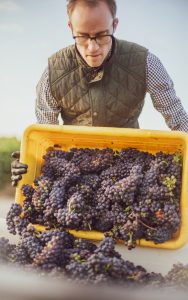
Originally, before I got into wine, I was a pre-med in college, and I had this whole idea of going to medical school. And I had this flash-forward, “Am I going to actually enjoy my quality of life in the future as a doctor?” And maybe I would, but maybe I could choose a more interesting profession.
So, I decided to come out to California. I got a job working in the laboratory at a large winery, which I did for about a year and a half, and then I went to Davis. I wanted a bit of work experience to contextualize how winemaking actually worked before I studied it academically. I studied the science, something I’ve always been attracted to, of winemaking to better understand the practice of winemaking.
From there, through my work experiences, I learned more of the craft and art of winemaking. It’s been a process of layering knowledge and experience in order to develop something new, like CARBONISTE, right? I had to develop the philosophy for CARBONISTE— that’s something that doesn’t happen overnight. Your mentors can’t give you your personal philosophy, you have to figure it out for yourself.
And so, from Davis, I ended up working in France at Domaine de la Romanée-Conti and got a snapshot of what winemaking is like there and also a snapshot into Burgundy. I would certainly take away different lessons today than I did then. And so, I would love to go back, of course, as it were!
GIVE US THE STORY OF CARBONISTE – THE BEGINNINGS & PHILOSOPHY.
I’m certainly glad to have the science background because coming in as an uninitiated to the winemaking craft isn’t easy. You can certainly make good wines, but you end up working from an evolving recipe and you don’t always know why you’re making good wines or what to do when problems arise. Having the background in science helps.
I ended up working for Schramsberg, who makes very traditional-style domestic sparkling wines. The goal of Schramsberg was to elevate California and try to make Champagne here, which sounds very apocryphal in California today. We don’t make Champagne – we make sparkling wine! But at the same time, we don’t really have a good narrative around that…
Sparkling wine doesn’t sound sexy; it doesn’t sound like “Champagne,” it’s not a brand in itself. And we can’t just call it our region, we can’t call it ‘Napa’, right? So, in working at Schramsberg, I saw what it meant to model yourself after this style of Champagne in California.
If you’re trying to make Champagne in California, from California fruit, you’re always going to fail. You can taste the difference between Sparkling Wine and Champagne instantly. You can taste the sunshine in the fruit here – the sweetness, the warmth. If you’ve got a piece of fruit sitting out in the sun, it tastes very different from an unripe piece of fruit that’s been growing in the shade. These are just very different pieces of fruit.
And so when I was at Schramsberg, I was thinking, “How could we make something that’s really special, respecting that difference in flavor from the beginning?” And to me, it really came down to how long you age it. There are some other inputs, but this question of how long do you age this wine after bottling, and before disgorging. If you age it for a long time, let’s say 18 months, or 60 months, or whatever, you end up with all these sweet, yeasty flavors; you hear people talk about brioche, and butterscotch, and caramel, and this sort of sweet component. So that flavor profile is happening, and the fruit is already sweet, like the fruitiness brings in sweetness.
And then you start layering on, like brioche, and caramel, and butterscotch, and I’m thinking, “why would you want mango with butterscotch?” It doesn’t sound good, right? It’s not a really compelling combination of flavors. And particularly as the fruit flavors age, they become more cooked in character. So, you go from this nice, bright orange, like mandarin orange, to marmalade, to marmalade and caramel. And it’s just too much.
And that’s how I started feeling about these California representations of Champagne. They’re too sweet just from their flavors. And then the other there’s relatively a lot of sugar in them, too, because they have a lot of acid. So, I was thinking, “how do we do it differently? How do we actually do it in a way that will help find a different balance point for California?”
And to me, it’s not letting it age because we’ve already got flavor from the vineyard – we’ve got terroir and we want to make that front and center. We’re trying to create a wine that’s transparent, that really shows to the consumer what that vineyard is about and what these grapes can do in California.
WHAT’S THE THOUGHT PROCESS BEHIND THESE WINES? WHAT HAVE YOU CHANGED FROM THE TRADITIONAL METHOD?
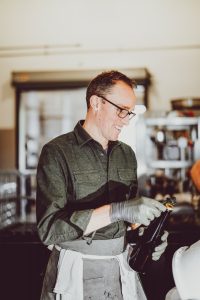
We’re mechanically doing more or less the same process as the traditional method, but we’re able to re-evaluate the process and innovate a bit:
We shorten the en tirage aging.
In Champagne, they legally need a minimum of twelve months en tirage, of aging on the lees. And to me, three months is fine because, for example with the Albariño, I don’t want it to taste like yeast. I want it to taste like the grapes. I want it to be about the varietal.
We use a crown cap.
It may seem like a cheap-looking thing to put on the wine. Champagne has to have a cork in it legally, and while they can’t use the crown caps for the final product, almost every single bottle of wine in Champagne, in their cellars, is closed with a crown cap. It’s when they disgorge and go to sell the wines that they put a cork in it. So, the cork is really only for aesthetics. To us, crown caps work better all around. It’s easier to handle, it makes for a better closure, it doesn’t taint the wine—you never get TCA from a crown cap.
The crown cap really is in the same vein as this modern California sparkling wine narrative, as we really drilled down to think about what’s best for our product and to express the terroir in a way that’s not just mimicking Champagne.
TELL ME ABOUT EACH WINE…
I think each wine in our lineup is truly unique– truly each is their own concept. That’s particularly true in our Critter series.
We’ve got our Albariño, it’s bright and fresh and really encapsulates the purity of the grape.
And then we added our Rosé. It’s meant to be fruity and fairly simple. This sort of like crushable Rosé-all-day, it’s meant to be a happy, bright, colorful wine that you could drink really without thinking.
And then we wanted to make a Pinot Grigio because we wanted to make a Pét-Nat. I like the concept of Pét-Nat — this idea of bottling during harvest and capturing that early essence of the wine and the natural sparkling wine concept, that the yeast is already there so let’s just use those to make the wine. We disgorge that wine to clean it up, so that there’s not a lot of sediment in the bottle. It’s still the essence of Pét-Nat, but it’s not dirty or mucky. It doesn’t have a lot of the issues that others, unfortunately, do have in the market. We didn’t want to make an unsophisticated, rustic product. We were aiming for something a bit more polished.
And then we made a sparkling red wine, which you guys haven’t seen yet because it will be released this summer.
The blend is 25% Merlot and 75% Albariño. We came up with this blend based on the fact that most sparkling red wines are too heavy; when you make a red wine, you got so much texture there that you then add bubbles, it can feel very muddy, it doesn’t lift and roll across the palette. It ends up being something you wouldn’t want more than half a glass of.
I wanted to make a Sparkling Red that you’d actually drink a bottle of. It could be a nice aperitif or something you could have with food. We did that by using 75% white wine and only 25% red wine in order to bring in the red character. It has just enough weight, tannin, some red fruits, but then it’s still lifted and vibrant, with the Albarino. And that’s how we kind of formulated that concept.
COULD YOU TALK ABOUT THE SINGLE VINEYARD RELEASES?
So we have our Critter Series – they’re all around the same price, they’re all very easy to get into, there’s a big variety in the series, and it’s a great entry-point to introduce consumers to this new idea of modern sparkling wine.
Then we thought, “how do we elevate this?”
While I was working at Schramsberg, there’d make 85,000 cases at the time. I think they’re closer to 100,000 cases now, and their smallest SKUs are 1,000 cases, or 2,500 gallons. I’d see this thousand-gallon tank that had this beautiful Chardonnay. I’m thinking, “oh my god, this would be a wonderful single-vineyard wine,” but it’s only 1,000 gallons so we can’t make it. To put that into perspective, my smallest lot is 200 gallons that we’ll bottle – so it’s a very different scale.
We’ll make things that are one-tenth the size of what Schramsberg would make. And so the idea of being able to really isolate these unique vineyards and unique expressions is a very different story. We can do that; we can kind of delve into single blocks and single vineyards and make those as finished products and really take the time and craft each one of those wines.
The single-vineyard wines are a little bit older, they’re about a year older than the rest of the inventory in the Critter series because Pinot Noir and Chardonnay need time. We don’t necessarily want to develop on lees. I mentioned before, we don’t want a lot of yeast flavor, and so we’ll leave the wine to age in barrel. We age it longer in barrel than a Champagne house would normally. And then we’ll give it nine months between storage and disgorging, and then we age it a little bit longer in bottle because I want to balance it out.
So we’ve got nine months in barrel, nine months on lees in bottle, and then nine months in bottle after disgorging. That, to me, is a really nice balance point to help the Pinot Noir and Chardonnay blossom.
And so we’re taking that as our model for production and applying it to different appellations, different single vineyards, and seeing how we can express a place like Marin County or the Santa Cruz Mountains with our ‘Corralitos’ wine.
Next year we’ve actually got a whole series of Santa Cruz wines coming out, focusing on distinctive areas within the Santa Cruz Mountains, which people may initially think of as monolithic, but these mountains are actually far more diverse than Napa County.
THE WINES
Albarino Extra Brut ‘Gomes Vyd’, Carboniste
A light and fresh sparkling wine with notes of gooseberry, kumquat, and stonefruit blossom. It is a fantastic aperitif wine and is guaranteed to pair with so many favorite recipes including grilled octopus!
ABOUT THE VINEYARDS
The Gomes family has been farming on Andrus Island since the 1800’s when they immigrated from Portugal, where Albarino (Alvarinho) is grown extensively in Vinho Verde near the Atlantic Ocean. This site has deep, rich soil, well fed from the Sacramento River. It is dry farmed without cultivation and is transitioning to organic farming certification.
Pinot Noir Rose Extra Brut, Carboniste
A fun and fresh sparkling wine with notes of wild strawberry and guava. It pairs well with a wide range of fresh foods, like uni.
ABOUT THE VINEYARDS
This wine is assembled from a range of cool-climate vineyards in the Santa Cruz Mountains, Marin County, and Anderson Valley. Dan & Jacqueline consider these to be the best appellations in California for sparkling wine, and carefully select barrels in order to create this unique sparkling rosé.
Pinot Grigio Pét Nat Extra Brut, Carboniste
This wine was an experiment for 2018– but has really taken off in popularity. This pét-nat is a fresh and clean example of petillant naturel wine, bottled in accordance with primary yeast sediment, it shows lovely yeast flavors along with primary fruit.
Early picking allows this wine to carry only 11% alcohol along with an abundance of energy and lightness.
Brut ‘California’, Carboniste
A step toward what you might expect from a more traditional producer, but it retains unmistakable brightness and energy that you’d expect from CARBONISTE. It has added weight from aging in barrel as well as in bottle, which allows this wine to handle fatty foods better than the core offerings. Consider pairing this wine with moules frites or steak tartare.
ABOUT THE VINEYARDS
This wine is assembled from a range of cool-climate vineyards in the Santa Cruz Mountains, Marin County, and Santa Rita. Dan & Jacqueline consider these to be the best appellations in California for sparkling wine, and carefully select barrels that contribute to this unique sparkling brut.
Brut Rose ‘Marin’, Carboniste
An emphatic, resounding response to basic rosé. It offers savory complexity along with balanced red fruit characters. Flavors linger on the palate and entice the next sip until the glass is empty.
ABOUT THE VINEYARDS
This wine is blend of two organically-grown vineyards in Marin County. Growing grapes in Marin county is not for the faint of heart. Marginal (cold) weather, disease, shallow soil, and lack of water all work against viticulture here.
Brut ‘Corralitos’, Carboniste
An exciting expression of the Corralitos area of the Santa Cruz Mountains, which produces highly expressive fruit that’s ideal for sparkling wines. Peach, nectarine, and bing cherry aromas with meyer lemon, ruby grapefruit, and Marcona almonds on the palate.
ABOUT THE VINEYARDS
Grapes for this wine are sourced exclusively from the Corralitos area of the Santa Cruz Mountains. This is a unique and highly expressive wine growing region due to very sandy soils and the strong influence of the Monterey Bay. This vintage includes two neighboring vineyards including Deer Park Ranch and the Francis J Vineyard.
 Husband and wife duo Dan and Jacqueline Person are producing some of the most innovative expressions of California sparkling wines out there. This smaller, younger (read: get in early with this brand!) Napa-based operation hit their stride with three flagship items, a bubbly Albariño, a fizzy rosé, and a pét-nat Pinot Grigio, while also perfecting some single-vineyard projects that represent unique, cool-climate California terroirs.
Husband and wife duo Dan and Jacqueline Person are producing some of the most innovative expressions of California sparkling wines out there. This smaller, younger (read: get in early with this brand!) Napa-based operation hit their stride with three flagship items, a bubbly Albariño, a fizzy rosé, and a pét-nat Pinot Grigio, while also perfecting some single-vineyard projects that represent unique, cool-climate California terroirs.









